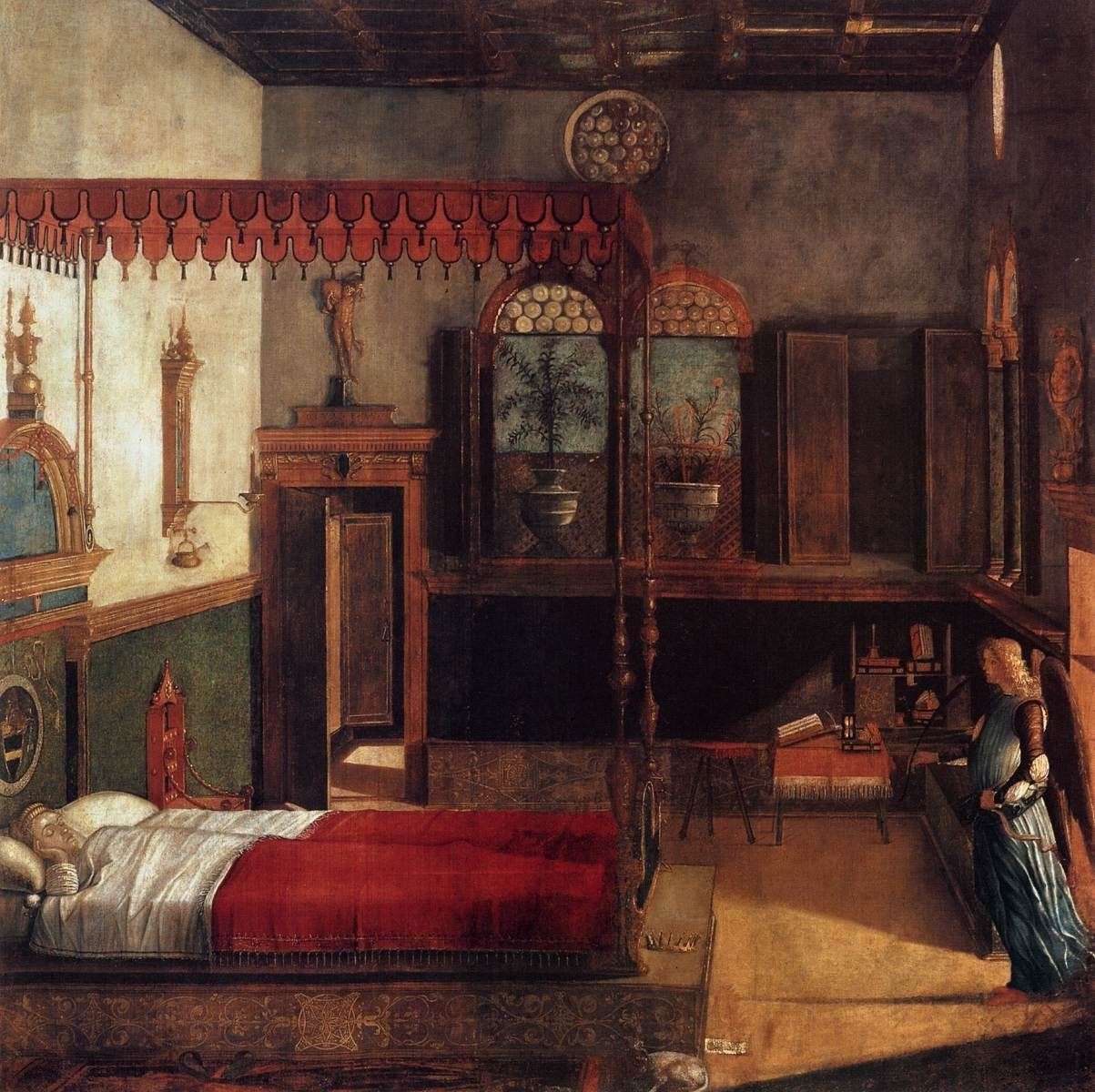HILDEGARD von BINGEN / Sequentia
Voice of the Blood
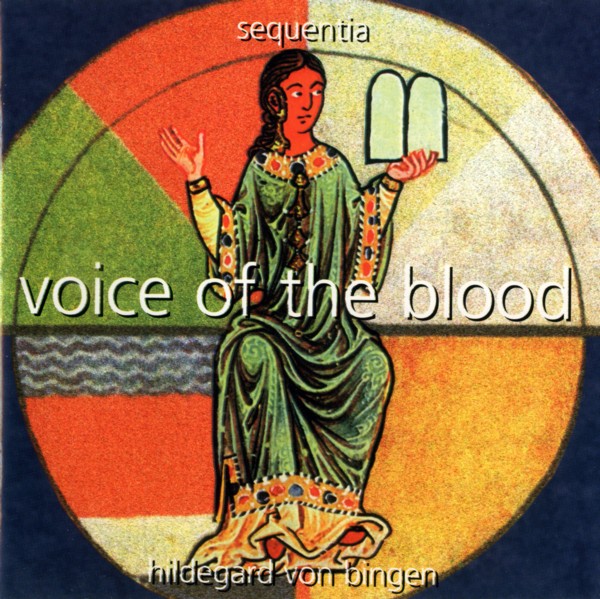
medieval.org
Deutsche Harmonia Mundi (BMG) 05472 77346 2
1995
1. O rubor sanguinis [2:03]
Antiphon to St. Ursula
Heather Knutson
2. Favus Distillans [8:29]
Responsory to St. Ursula and the 11,000 virgins
ensemble, fiddle, symphonia
3. Laus Trinitati [1:36]
Antiphon in Praise of the Trinity
Gundula Anders
4. In Matutinis Laudibus [9:53]
Office for the Feast of St. Ursula
1. Studium Divinitatis
2. Unde quocumque
3. De patria
4. Deus enim
5. Aer enim volat
6. Et ideo puellae
7. Deus enim rorem
8. Sed Diabolus
ensemble, intonation: Pamela Dellal,
Carol Schlaikjer, Elizabeth Glen, solo in 7.
5. O Ecclesia [7:57]
Free Sequence to St. Ursula
Barbara Thornton, ensemble
6. Instrumental Piece [6:34]
Elizabeth Gaver · based on 'O viridissima virga'
fiddle, portative organ, symphonia
7. O aeterne Deus [2:12]
Antiphon to God the Father
Janet Youngdahl
8. O dulcissime amator [6:46]
Symphonia of the virgins
solo: Pamela Dellal, Nancy Mayer, Consuelo Sañudo, Lucia Pahn
ensemble: Elizabeth Glen, Janet Youngdahl
9. Rex noster promptus est [6:25]
Responsory to the Innocent
ensemble, Lucia Pahn, organistrum
10. O cruor sanguinis [1:36]
Antiphon
Carol Schlaikjer
11. Cum vox sanguinis [6:32]
Hymn to St. Ursula
ensemble
12. Instrumental Piece [3:00]
Elizabeth Gaver, based on the D-modes of Hildegard
fiddle, portative organ
13. - [7:48]
O virgo Ecclesia
Antiphon for Ecclesia · ensemble, organistrum
Instrumental Piece
Elizabeth Gaver · fiddle
14. Nunc gaudeant materna [2:27]
Antiphon to Ecclesia
Gundula Anders, Elizabeth Glen, Carol Schlaikjer, Janet Youngdahl, ensemble
15. O orzchis Ecclesia [3:39]
Antiphon to Ecclesia
ensemble
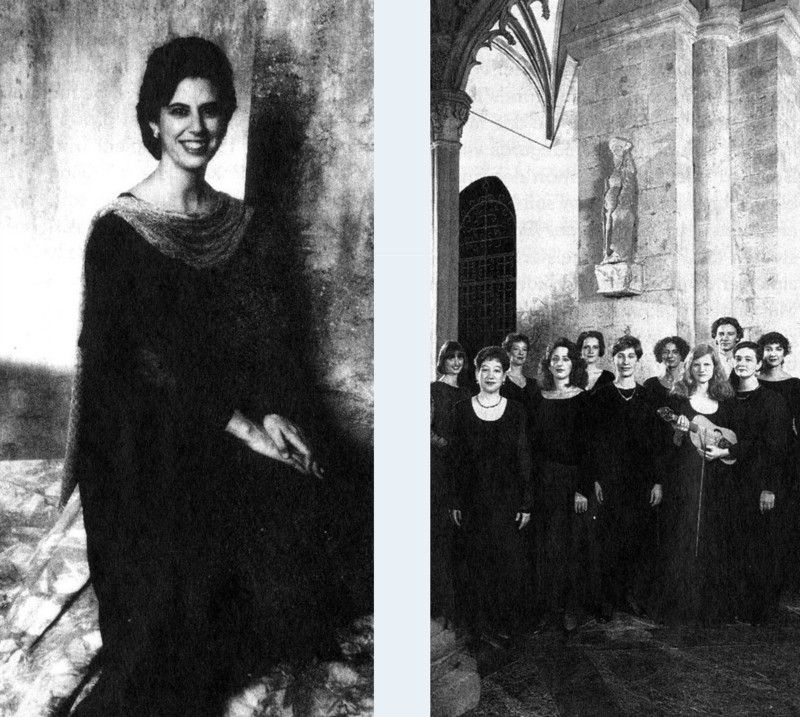
SEQUENTIA, Ensemble für Musik des Mittelalters
Barbara Thornton & Benjamin Bagby
Barbara Thornton, voice, portative organ
voices:
Elizabeth Glen, Janet Youngdahl, Carol Schlaikjer,
Nancy Mayer, Pamela Dellal, Heather Knutson,
Lucia Pahn, Consuelo Sañudo, Gundula Anders
Elizabeth Gaver, fiddle
Joachim Kühn, organistrum, symphonia
Instruments:
Fiddle: Rainer Ullreich, Wien 1991
Portative organ: Louis Huivenaar, Jan de Bruijn, Amsterdam 1983
Symphonia: Bernard Ellis, Dilwyn, Herefordshire, GB 1978
Organistrum: Alan Crumple, Leominster, GB 1982
Assistant to SEQUENTIA: Joachim Kühn
Assistance by Laurie Monahan and Elisabetta de Mircovich in
transcription work is greatly appreciated.
Arrangements:
Barbara Thornton, Elisabeth Gaver
All arrangements, transcriptions, and reconstructions of Hildegard von
Bingen's music by Barbara Thornton are protected under copyright law
and may not be used by others without express permission.
Latin texts from:
„Hildegard der Bingen. Louanges” Traduites du Latin et
présentées par Laurence Moulinier.
© Orphée / La Différence, Paris 1990.
Music sources:
Rupertsberger „Riesencodex” (1180-90) Wiesbaden: Hessische
Landesbibliothek, Ms. 2, f. 466 ff.
All pieces performed from diplomatic editions based on direct
consultation with Wiesbaden Ms, prepared by Barbara Thornton.
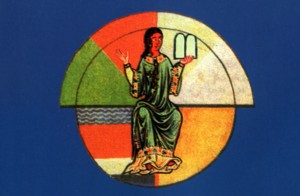
Dedication:
We dedicate this recording to the memory of all victims of violence.
(P) + (C) 1995 BMG Music
Executive producer: Jan Höfermann
Producer: Klaus L Neumann
Recording supervision: Barbara Valentin
Balance engineer: W. Sträßer
Editing: A. Plagmaker
Mastering: Andreas Neubronner (TRITONUS)
Recorded: 30. October-3. November 1994, St. Pantaleon, Köln
Front cover picture: Miniature from Codex Latinus 1942
Design: Ariola/Strada
Art direction: Thomas Sassenbach
Text editing: Dr. Jens Markowsky
All rights reserved
BMG / BERTELSMANN MUSIC GROUP
Eine Coproduktion mit Westdeutscher Rundfunk Köln
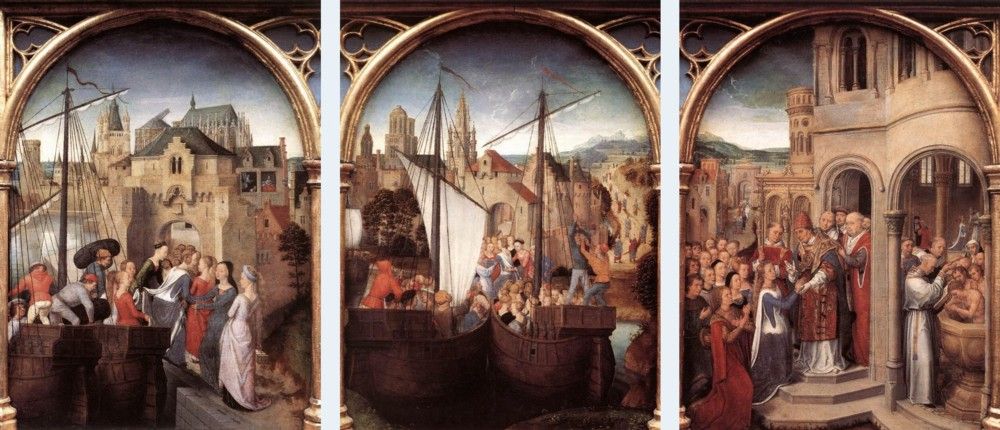
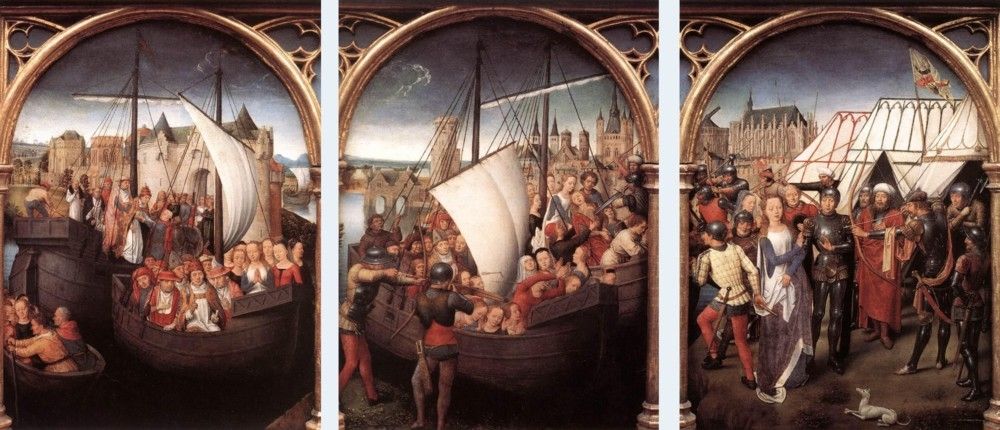
This recording marks the second in the series of Sequentia's BMG/DHM
recorded productions of the complete musical works of Hildegard of
Bingen. The first, entitled Canticles of Ecstasy, presented a
selection of her compositions of relatively ambitious scope: Marian
songs possessing intricate theological and imagistic programs were
contrasted with similarly complex songs dedicated to the Holy Spirit.
Perceiving the Cosmos as animated by both a feminine and masculine
divine force, Hildegard was able in these praise-songs to give an
insight into the two opposite but equally powerful universal poles of
energy.
The present series of her symphoniae creates such
juxtapositions on a more specific, "human" level. In the story of
Ursula and the 11.000 virgins we see crystallized in the form of a
human woman the tenderness of nature, humility and receptiveness to
spirit which Hildegard found magnified to celestial proportions in
Maria, but also the rock-solid strength of virgin devotion which stands
up to misunderstanding, mockery, even death, allowing it to ultimately
partake in supra-terrestial celebrations of the blessed which await the
purest and most steadfast of souls.
Hildegard von Bingen's spiritual compositions represent a pinnacle of
individual creation in an distinguished age of art and thought. The
twelfth century is widely referred to as having witnessed a
"Renaissance" in the sense of a full cultural flowering, and this
reputation is largely due to the exceptional intellectual vigor,
philosophical depth, and aesthetic brilliance of the monastic arts of
the time. The manner in which theological renewal, economic well-being,
and far-reaching social innovations came together to support monastic
life accounts in part for the phenomenal musical and literary output of
Hildegard von Bingen and some of her contemporaries. As of the age of
eight, she lived the cloistered life according to Benedictine Rule,
first in the double (male and female) monastery called Disibodenberg,
west of the Rhine, and then, at the height of her powers, as the leader
of her own community at Rupertsberg on the Rhine at Bingen. As abbess
of Rupertsberg, Hildegard's authority, fame, and creative power
increased significantly. Between 1151 and 1158 she was writing and
collecting her musical compositions intended to be sung by the sisters
at the convent at liturgical and other functions. She called them symphoniae
harmoniae celestium revelationum, a title meant to indicate their
divine inspiration as well as the idea that music is the highest form
of human activity, mirroring as it does the ineffable sounds of
heavenly spheres and angel choirs. It was also during this thus that
she carried out an extensive correspondence with important
personalities in ecclesiastical and temporal circles, as well as
turning her energies to compiling encyclopaedic works on natural
science and the healing arts
In her own time, as in ours, the “Sibyl of the Rhine”
amazes those with the ears to hear her. “It is said that you are
raised to Heaven, that much is revealed to you, and that you bring
forth great writings, and discover new manners of song ...” wrote
Master Odo of Paris in 1148. Then, as now, she is admired for
fearlessly exploring the cosmos with her vision, for creating a moving
feminine theology which nonetheless remains in awe of both the
masculine and feminine divine powers. Her ability to function in the
real, political world is as impressive as her complete dedication to
the life of the soul, and to nurturing it among her cloistered sisters.
Ursula and Ecclesia: Myths and Meaning
Of all the subjects and personages which inhabit Hildegard's poetic
cosmos only the Virgin-Mother Maria received the homage of composition
more often than the saint and martyr, Ursula of Cologne. St. Ursula was
a young woman who, along with her companions, 11.000 virgins, was
reportedly martyred in that city by barbarian soldiers. As attested to
by a stone inscription from the IVth century (discovered in the IXth
century) her cult was an ancient and lively one, spreading throughout
Europe from its center at the church in Cologne which still bears her
name. In the 12th century worship of this saint reached an apogee due
to the discovery at the Ursula church site of an old Roman burial
ground full of bones purported to be the actual remains of the
slaughtered women. In addition, another cloistered visionary,
contemporary to Hildegard, Elisabeth of Schönau, was receiving
visions relating to the life and martyrdom of Ursula, causing a
feverish interest in her cult as a result. It is known that Elisabeth
and Hildegard were in correspondence, and perhaps shared this vital
interest in St. Ursula.
Her legend unfolds in a remote early-Christian time: She was the
daughter of baptized Breton royalty, and promised in marriage (under
duress) to the son of the King of England. Raised a Christian, she
resisted with horror the idea of marrying the barbarian English prince,
but was saved this fate by the visitation of an angel. He instructed
her to demand a three-year reprieve from the marriage promise, to
undertake a pilgrimage under royal and ecclesiastical patronage to
Rome, stopping in Mainz, Basel and Köln on the way in the company
of eleven other noblewomen (the number eleven seems to have mutated
into the traditional number 11.000 through scribal vagaries). Having
been enthusiastically received by the Pope in Rome, this crowd of
virgins met its tragic end while stopping in Cologne on their return
trip at a time when Attila the Hun was besieging the city (not a
historically defensible scenario, but a very colorful one just the
same). The 12th century fervor for Ursula's cult was expressed mainly
through trafficking in her relics (the newly-found bones from Cologne),
in numerous paraliturgical compositions dedicated to her, presumably
intended for her feast-day celebrations on October 21st, and in
relatively modest visual representations of her virgin followers. By
the 15th century the Ursula legend was favored by many masters, and can
be found in elaborately executed works such as frescoes, paintings, and
altar pieces, in all parts of Europe (the most notable being Memling's
altarpiece in Bruges and Carpaccio's canvas in Venice).
Hildegard's strong identification with this figure goes beyond the
enthusiasm demonstrated in her lifetime; as the leader of a spiritual
community for women, as the model of purity and love for the Divine, as
bearing up to the vicissitudes of outside opposition and the
responsibilities of inspired leadership, as a figura for the
apotheosis of the human soul within the sacred space of Ecclesia,
and for the ultimate realization of that sacredness in eternal space
and time, she found in the figure of Ursula a thematic complex around
which her fondest poetic fictions could freely pivot. Musically, she
was able to achieve something like a “song-cycle” which
begins with the simple image of the redness of shed blood and ends in
the grand visions of Ecclesia in all the tragedy and
magnificence which tradition bestows on this figure.
Ecclesia is the Latin form of a similar Greek word meaning
"gathering", "assembly". Thus it is literally synonymous with the word
"synagogue", (also Greek). Before this word came to signify "church",
as a church building, or the Christian Church, it represented the idea
of a collective, per se: a people before its god, or even the space
suited to receiving spirit, be it within the soul of an individual or
within a community. In the course of centuries the concept was
expressed in the form of a female figure rich in amplifications and
resonances, as attested to in numerous examples of ecclesiastical
iconography and textual exegesis. She was the archetypical, eternal
Heavenly Community; Jerusalem, or the daughter of Jerusalem; the
mountain of Zion; She was the original and final manifestation of those
in union with God: Bride and Beloved of Solomon, of Christ; their
temple, synagogue, church; She was the epiphany of the feminine: the
very soul itself, the soul of a people, or of a people living in
expectation of union with its god-eternally existing, eternally waiting
to become the divine dwelling for Divine Wisdom. We learn through
Hildegard's Ursula works that the saint greatly desired to make of
herself that dwelling place for Wisdom, and that the force of her
personal Ecclesia created a multitude of similarly dedicated
women around herself. Certainly the same could be said of Hildegard von
Bingen.
In the Embrace of Ecclesia
We present here a series of Hildegard's compositions with reference to
her own programmatic positioning of pieces in the manuscript created at
her abbey, and according to thematic and formal groupings. This effort
has been aided by the invaluable insights provided by two of the
leading Hildegard scholars today: Peter Dronke and Barbara Newman. (For
more detailed treatment of these poems the reader should refer to the
works of these authors). A veritable dramaturgy results from aligning
the pieces in their present order, whereby we perceive that Hildegard
has woven together through the immediacy of her images and personages
themes which spring from the Biblical text traditions of Song of Songs,
and the Apocalypse, and the early Christian figure of Ecclesia.
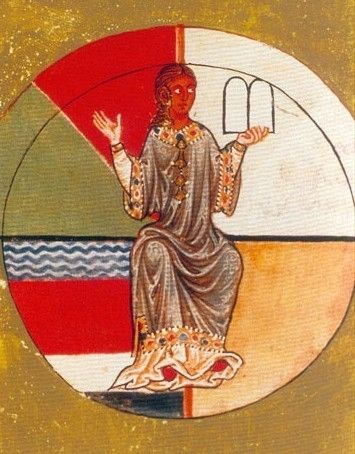
The pieces
1.) O RUBOR SANGUINIS
The cycle opens with the searing image of red blood flowing between
Heaven and Earth, the most binding of covenants. Through mere hints in
her text and a masterfully succinct melody, we feel the horror of death
transformed into contemplation of it as a tender, eternal flower.
2.) FAVUS DISTILLANS
Opens to a world of nature and longing reminsiscent of the Song of
Songs: Mel et lac sub lingua eius: “honey and milk
beneath her tongue” implies the complete fulfillment of all
higher senses and desires. To show the snow-white purity of Ursula and
her multitude they are likened to a garden of apple-blossoms.
3.) LAUS TRINITATI
An energetic exclamation to the Trinity as an animating force closes
off this vision of Paradise as a call to worship to begin the quasi
story-telling cycle of antiphons which immediately follows.
4.) IN MATUTINIS LAUDIBUS This cycle was surely intended
to be sung at Hildegard's cloister during the canonical hours, and in
praise of Ursula on her feast-day (October 21). It attests to the fact
that such special days in the church year most have been richly
celebrated, and have served as outlets for Hildegard's compositional
skill. This marvelously constructed series combines the actual story of
Ursula with some very specific ideas Hildegard wanted emphasized: It
alternates between the traditionally designated feminine E-modes (i.e.
antiphons 4, 7) and the masculine dignity of the D-modes (i.e.
antiphons 6, 8), thereby favoring us with insights into her stated
concept of how females' very particular sort of spirituality rests upon
and is protected by the fundament of male organization and authority.
(Hildegard has occasion in her life to both profit and suffer from this
perceived natural order). A bold truth of life finds expression in the
concluding D-mode piece: ... Qua nullum opus Dei intacta dimisit:
“... for no work of God's remains untarnished”.
5.) O ECCLESIA
Barbara Newman claims this piece as “one of Hildegard's most
stunning achievements”; surely the same could be said of Newman's
analysis of it in her edition of translations of the Symphoniae.
Peter Dronke has written of the opening address to Ecclesia,
“Hildegard begins with an astonishing composite image, laden with
prophetic and mystical associations from the Old Testament. In her
visions in Scivias, and in the illuminations made under her
supervision to accompany them, Ecclesia is seen as larger than
life, but still as a recognizable womanly figure. Here Ecclesia
is a figure of cosmic dimensions, and Hildegard does away with the last
traces of realism. The sapphire of her eyes evokes the throne in
Ezekiel's vision of the Son of Man; her ears, the porta caeli
(Heavenly gates) of Jacob's dream, where earth and heaven seemed
nearest to each other; her nose, the fragrant place where the lover in
the Song of Songs waits for his bride; her mouth evokes that roar of
waves which, coming from the wings of the four living creatures, seemed
to Ezekial ‘quasi sonum sublimis Dei’ (‘like to the
sublime sound of God’)”.
This sublime quality of the poem, and its ambitious range, are
beautifully captured in Hildegard's D-mode tour de force setting. The
opening strophes are drenched in the emotion of “desiring
desire” which is Ursula's; as she is put to the test in this
desire, so does the music of the piece gain in complexity. Extremes of
range and of mode are employed for the painting of images such as
“purest ether” (purissime aere), “fiery
burden” (ignea sarcina), “the devil's members
invaded” (= agents of destruction in the world, membra sui
invasit). Decorative and expressive gestures ornament words like
“pearls from the matter of the Word of God” (margaritis
materie Verbi Dei), “desired with desire” (desiderio
desideravit), and “murdered” (occiderunt).
Hildegard even bursts out of the Latin tongue with the German
ecclamation of profound grief, “Wach!” at the
moment when Ursula's blood sacrifice is heard from the earth below by
the powers and elements of the universe above.
6.) INSTRUMENTAL PIECE
The following instrumental piece in G-mode, constructed by Elizabeth
Gaver, weaves together both freely and in a stately structure some of
the most tender of Hildegard's 8th-mode gestures. As this mode in the
12th century was thought to be most indicative of the state of
blessedness, bestowing upon the listener inner peace and meditative
quiet, its effect is to offer comfort after the harsh realities put
forth in the last antiphon of the foregoing cycle.
7.) O AETERNE DEUS / 8.) O DULCISSIME AMATOR
This individual prayer serves as a prelude to the subsequent communal
one: in Hildegard's rubric it is dedicated to the virgins, but should
perhaps be conceived as being sung by the virgins who “in
Ecclesia” and like Ursula, direct their ardor to the Highest
Love, the highest Lover.
“In your blood we were wed to you”, echoes words which
could be spoken by the figure of Ecclesia, who is often
pictured beneath the crucified Christ with a chalice to catch the blood
spilling from his side. All the pity and passion of such complete
identification with a divine lord, and awe for the miracles of embodied
divinity are heard through sneaky, arousing E-mode incantations, both
individual and “in symphonia”.
9.) REX NOSTER PROMPTUS EST
Receiving blood-sacrifice from earth, “Angels sound harmoniously,
and in praise together, but the clouds weep for their (the innocents)
shed blood”.
This strong, stark E-mode piece reminds us that, while Heaven rejoices
and builds its eternal city through the purity of souls who have
sacrificed themselves through love of the Divine, the extreme pain of
sacrifice is felt on this earth. Hildegard is able to reflect both the
majesty and the sorrow of these ideas through one and the same mode.
10.) O CRUOR SANGUINIS / 11.) CUM VOX SANGUINIS
The short antiphon confronts us once more with the sadness of innocent
bloodshed. While written in the same mode as O rubor sanguinis,
it seems to address our human feelings in the face of such tragedy,
here serving as a prelude to the next piece, a visionary
“Ordo” which plays itself out in cosmic time and space.
This composition constitutes one of Hildegard's major works. It begins
again with the image of blood: the blood of sacrifice which in its
agony cries out to Heaven where it is heard and received and submitted
to transformations. The drama of this vision is accomplished through
the unending powers of invention which are Hildegard's as she molds the
classic D-mode figures around her procession of images springing from
Old Testament events, myths, prophetic lore, and the Ursula legend.
Hildegard of Bingen uses the Old Testament topologies which show the
dynamics (and dangers) of human convenant with Divinity to foreshadow
Ursula's own relationship to her God and to her sacrifice. The ram
caught in the thicket is the innocent animal God substitutes for the
blood sacrifice Abraham is asked to make of his only son to Jahweh
(Gen. 22,13). God appears directly to Abraham in Mamre (Gen. 18,1), but
turns his back on him later (Ex. 33, 20) saying, “No man shall
see me and live”. The Biblical book Leviticus spells out the
ancient protocols of meat sacrifices. When He shows Himself to Moses,
He does so as a burning bush (Ex. 3, 1-4). By invoking the old and
innovating anew she apotheosizes Ursula's devotion: we learn that in
Heaven she loses her earthly name, Ursula, (meaning
“she-bear”, symbol of earthly spiritual strength) and is
given the heavenly name “Columba” (meaning
“dove”, symbol not only of the purity of her own soul, but
of the congregation of pure feminine souls around her, a kind of “ecclesia”.)
Ecclesia in person is invoked at the end as the piece climaxes
in a vision derived from the one found in the Biblical Apocalypse where
New Jerusalem's 12 gates are seen to be built of 12 precious stones
(here she mentions sapphire, topaz, and gold of the whole city).
12.) INSTRUMENTAL PIECE
This composition reflects the noble generosity of the D-modes of
Hildegard's antiphon cycle, (piece 4, antiphones 6,8). In it we can
feel the joy and glittering brightness of the foregoing
Jerusalem-vision.
13.) O VIRGO ECCLESIA / 14.) NUNC GAUDEANT
/ 15.) O ORZCHIS ECCLESIA
In Hildegard's manuscript, the songs dedicated to Ursula are followed
by Ecclesia pieces. The first of the series begins with a
bitter lament addressed to Ecclesia who is pictured here as
both virgin and mother whose children have been ripped away from her
sacred, protecting viscera by vicious wolves. Rarely has Hildegard used
such strong language, both verbal and modal, to arouse our
understanding of the suffering of separation from Spirit. As a postlude
we give expression to the sorrow of such pain in a fiddle piece
constructed by Elizabeth Gayer which also emphasizes figures in E-mode
capturing the extreme emotions of the lament to Ecclesia. The
suffering is immediately dispersed in this, one of Hildegard's most
exuberant pieces which rejoices at the restoration of souls to Ecclesia's
embrace. The cycle concludes in otherworldly solemnity achieved by her
giving the E-mode an ethereal manifestation, and in texts partially
written in Hildegard's lingua ignota, or secret language. Privy
to visions, both aural and optical, which surpassed her abilities of
expression, she devised a vocabulary of words (a mixture of Latin and
German) needed to give utterance to the unutterable things she saw and
heard. In her musical works she resorted to her secret language only in
this piece in order to render something of the mystery of Ecclesia
— realized and unrealized community of Spirit.
Barbara Thornton
